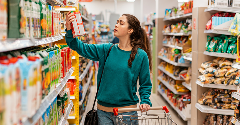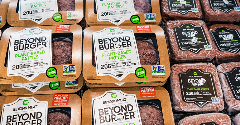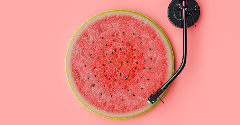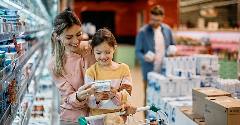News
Food and Beverage Colours: Consumers Demand a Natural Rainbow
10 Sep 2013Colour influences our food choices more than we realise. The main purpose of colour ingredients in food and beverages is to offset the colour that is lost during processing, or to enhance the naturally occurring colour. Nobody wants a fruit flavoured drink that’s a pale shade of brown or canned vegetables that have a similar […]

Colour influences our food choices more than we realise. The main purpose of colour ingredients in food and beverages is to offset the colour that is lost during processing, or to enhance the naturally occurring colour. Nobody wants a fruit flavoured drink that’s a pale shade of brown or canned vegetables that have a similar hue to a dirty pond. Without colour ingredients, this would be the reality. Consumers also closely associate colour with flavour, with brighter colours in food associated with stronger, richer tastes. In recent years, research and development of natural product colours has focused on fruit, vegetable and plant extracts and concentrates – food’s original colour palette.
Colour ingredients are also used to attract consumers’ attention, with the use of vivid, playful colours in products such as sugar confectionery, ice cream and soft drinks. However, food safety has cast a shadow over brightly coloured foods in Europe after a group of researchers at Southampton University confirmed in 2007 that the consumption of several synthetic food colours, including allura red and sunset yellow and dubbed the ‘Southampton Six’, were associated with behavioural problems in children. Rather than being attracted to coloured products, European consumers now ask themselves “What is in that to make it so bright?” and “Is that coloured food safe for my child to consume?” While all food additives are scrupulously tested by the European Food Safety Authority, when it comes to colour ingredients the European preference is overwhelmingly natural.
This is not the case in other parts of the world – at least, not yet. Euromonitor data shows that in 2012, Asia Pacific consumed over a quarter of all synthetic food colours globally, making it the second largest consumer of synthetic food colours after the US. Awareness of the use of natural and synthetic ingredients in processed food remains low in this region – hence the relatively low demand for natural colours in comparison to Europe. However, a rising middle class in countries such as China, Indonesia and India, with an increased interest in food safety, has led to a rising demand for more natural and healthy ingredients, including natural colours. Given the size of the food and beverage market in Asia and its strong rate of growth – in 2017 it is expected that Asia Pacific will consume nearly as much packaged food as Western Europe and North America combined in volume terms – this region perhaps has the most potential for growth for natural food and beverages.
The US is the world’s largest market for natural product colours, consuming over 430,000 tonnes of natural product colours in food and beverage products in 2012. Germany is the only European market to feature in the largest five markets for natural products colours. Because of their sheer size, China, Mexico and Brazil are the second, third and fourth largest consumers of natural product colours in food and beverages globally.

Related news

Retail landscape lacks nutritious and affordable food, says ATNi
30 Dec 2025
A rapid increase in modern food retail has given retailers growing influence over consumer diets, according to global non-profit ATNi’s latest assessment.
Read more
Debate over ban on ‘meaty’ names for plant-based products reaches stalemate
26 Dec 2025
The debate over a ban on plant-based products using “meaty” terms has reached a stalemate, leaving manufacturers in limbo and still facing overhauls to their marketing and packaging.
Read more
Multi-sensory food and drink products to gain traction in 2026
16 Dec 2025
Trend forecasters predict that sensory elements will play a larger role, helping food and beverage brands differentiate themselves in a competitive market in 2026.
Read more
Big appetite for M&A between European and US food and drink companies
3 Dec 2025
Persistent tariffs on EU food and beverage exports have helped drive record levels of M&A activity between European and US companies this year, according to analysis by ING.
Read more
Non-UPF Program extends certification scheme to entire food industry
30 Nov 2025
The Non-UPF Program has extended its certification scheme to the wider food sector, championing a move towards healthier consumption habits.
Read more
Lancet study links UPFs to chronic disease risk
26 Nov 2025
UPFs are consistently associated with an increased risk of diet-related chronic diseases, according to a comprehensive review of global evidence in The Lancet .
Read more
Concerns swirl around cinnamon’s compliance with EU law
25 Nov 2025
Cinnamon may be a top functional ingredient, but it needs stronger protocols to ensure it meets EU food safety laws and quality standards, say researchers.
Read more
Oat Barista: Innovation for game-changing beverages
20 Nov 2025
Oat Barista is a clean label, sustainable, and innovative drink base specifically designed to create the perfect foam in one single ingredient.
Read more
How younger consumers are redefining ingredient choices and rejecting brand loyalty
18 Nov 2025
Gen Z and millennial consumers’ preferences for transparency, functionality, and purpose are “redefining the very nature of consumption itself”, says SPINS.
Read more
Hybrid formats and flexible positioning to disrupt category norms in 2026
17 Nov 2025
Trend forecasters expect food and drink to move more fluidly across occasions, functions, and formats as consumers seek versatility, novelty, and convenience.
Read more